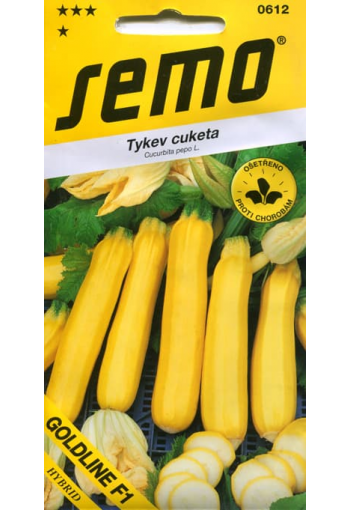Ex Tax: 1.23€
The fruits of this hybrid are amazing for cooking squash caviar and for canning!
Bush. The fruits are cylindrical, up to 20-60 cm long, yellow in color, amazing in taste, suitable for dietary nutrition, canning and cooking various vegetarian dishes.
The fruits contain a lot of vitamin C and minerals. This hybrid is characterized by a long fruiting period and a stable yield.
Quickly restores fruiting after stressful conditions. Resistant to powdery mildew.
1,0 g = 10-15 seeds.
Agricultural technology.
For zucchini, light, fertile soils with low groundwater are most suitable; it does not tolerate acidic soils.
The best predecessors are early vegetables, onions, root crops, tomatoes, potatoes.
Before planting, the site is dug up and fertilized with organic and mineral fertilizers, as well as ash, and lime if necessary.
Sowing of seeds is carried out in late May - early June after spring frosts have passed. Seeds are sown in holes 2-3 pcs. The distance between the holes is at least 60 cm.
After the emergence of shoots, the weak plant is carefully removed. Seedlings are sown for seedlings in early May, seedlings are planted in open ground in early June in the phase of 2-4 leaves.
Further care consists in regular watering, loosening, hilling and top dressing. Fruits are harvested regularly with an interval of 2-3 days, preventing them from overripening.
Zucchini can also be grown through seedlings.
Eng.: Zucchini Squash. Suom.: Kesäkurpitsa. Sven.: Sommarpumpa.
* Use and storage of zucchini.
Young unripe fruits are used to prepare numerous dishes, they are fried, baked, stuffed, salads, caviar, pancakes are prepared, and they are also preserved for the winter.
Collected fruits are stored at a temperature of +4 + 6 ° C and a humidity of about 85-90%, most often on the bottom shelf of the refrigerator in a plastic bag with holes or in enameled dishes.
In this case, the shelf life of young zucchini (zelentsy) is about 15-20 days.
Ripe but not overripe zucchini can be kept fresh for up to six months. To do this, the fruits must be undamaged, have a stalk, be in a dark and dry place.
After February-March, the seeds inside the vegetable can germinate, while the pulp becomes bitter and unsuitable for food, so it is recommended that the zucchini be cleaned at this time, remove the seeds, and cut and freeze the edible part.
When storing zucchini zucchini in cellars in the absence of condensate, their taste remains unchanged until the new harvest, which is another advantage of zucchini.











